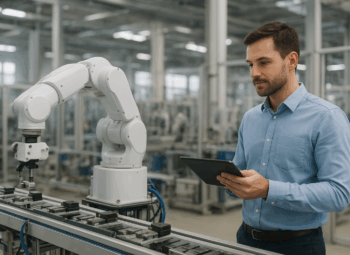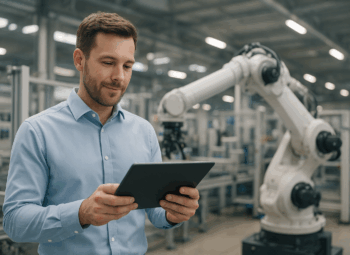Research Output: -1759902022
Introduction — Modern mental health issues in industrial environments
Factories and production sites face more than mechanical and logistical challenges. Workers experience stress, fatigue, and cognitive overload from repetitive tasks, long shifts, and unclear feedback loops. These mental health pressures reduce productivity, increase error rates, and elevate safety risks.
AI tools can help. They improve job design, balance workloads, and provide real-time support. Leaders can combine AI-driven systems with human-centered policies to address mental health while advancing operational performance.
1. How AI tools integrate with factory operations
From data collection to actionable intelligence
Factories generate streams of data from machines, sensors, and workforce systems. AI ingests this data and translates it into prescriptive actions.
AI tools deliver three clear operational benefits:
- Faster decision-making through real-time analytics
- Reduced unplanned downtime with predictive alerts
- Clearer operator guidance via augmented work instructions
Example: A mid-sized assembly plant deployed edge AI to analyze vibration and temperature data. The system flagged component wear before failure, allowing a planned swap during low-demand hours. The team reduced emergency maintenance and avoided overtime stress on technicians.
2. Supporting workforce mental health with AI-driven systems
Designing systems that reduce cognitive load
AI can simplify complex tasks. It can sequence instructions, hide irrelevant data, and surface only the next steps, reducing cognitive fatigue among operators.
Practical examples
- Adaptive shift scheduling: AI balances production needs with employee rest patterns, minimizing burnout.
- Real-time fatigue detection: Camera-based posture and micro-behavior analysis identify fatigue risks and prompt breaks.
- Digital work instructions: Interactive AR overlays reduce errors and improve confidence on first-time tasks.
Benefit-driven outcome: Plants that use adaptive schedules report steadier output and lower overtime rates. Operators show improved job satisfaction because work feels predictable and supported.
3. Production optimization and predictive maintenance
Reducing interruptions, improving throughput
AI enables predictive maintenance and dynamic scheduling. These features maintain flow and reduce stress caused by sudden stoppages.
Key capabilities include:
- Condition monitoring with trend analysis
- Automated spare-parts prediction and inventory triggers
- Smart scheduling that aligns maintenance with low production windows
Example: A construction materials manufacturer used machine learning to forecast wear on extrusion dies. The company scheduled replacements during planned slowdowns and reduced scrap rates. Technicians experienced fewer emergency calls and gained predictable maintenance routines.
4. Compliance, factory verification and carbon-neutral supply chains
Ensuring verifiable practices with AI
Regulatory compliance and factory verification require transparent, auditable records. AI systems aggregate diverse data sources to create tamper-evident logs and compliance dashboards.
How AI supports carbon-neutral goals
AI models calculate emissions across processes and suggest low-carbon alternatives for energy, materials, and logistics. Companies can target the highest-impact areas and track progress toward carbon neutrality.
- Automated emissions accounting across sites
- Supplier scoring for carbon performance
- Optimization of routing and loads to reduce transport emissions
Benefit-driven outcome: Buyers and auditors receive clear evidence of compliance. Sourcing teams gain data to negotiate with suppliers around decarbonization commitments.
5. Implementation roadmap — practical steps and case studies
Stepwise approach to adopt AI in factories
Adopt AI in measured phases. Start with focused pilots, prove value, and scale. Follow these steps:
- Identify pain points tied to worker wellbeing, throughput, or quality
- Collect baseline data for 4–12 weeks
- Run a targeted pilot with clear KPIs (safety incidents, downtime, error rate)
- Train staff and iterate the user interface to reduce friction
- Scale successful pilots and integrate with supplier and logistics systems
Real-world example
A supplier verification program used a layered AI approach. The system combined satellite imagery, on-site sensor feeds, and supplier-submitted data to verify production rates and emissions. Compliance teams reduced audit time by 60%. Floor managers used simplified dashboards to monitor worker breaks and machine load, improving safety compliance and reducing stress-related incidents.
Key features of effective AI deployments
Successful AI systems focus on human and operational outcomes. Include these features in vendor and internal evaluations:
- Low-latency edge analytics to reduce alert fatigue
- Transparent models with explainable recommendations
- Privacy-first worker monitoring with opt-in policies
- Interoperability with MES, ERP, and supplier portals
- Role-based interfaces that display only relevant actions
Actionable insights for supply chain and sourcing leaders
Use AI to align operational excellence with workforce wellbeing. Focus on measurable KPIs such as:
- Reduction in emergency maintenance events
- Improved on-time delivery through dynamic scheduling
- Lower employee turnover in high-stress roles
- Verified emissions reductions across supplier network
Start by running a small pilot that targets one bottleneck and one wellbeing metric. Document results and decide whether to scale based on quantifiable improvements.
Common pitfalls and how to avoid them
Avoid these common mistakes when deploying AI tools:
- Skipping worker consultation: Involve operators in design to prevent rejection and reduce stress.
- Relying on opaque models: Choose explainable systems to maintain trust.
- Ignoring data hygiene: Clean input data to prevent false alerts and unnecessary interventions.
- Over-automation: Keep the human in the loop for critical safety and quality decisions.
Conclusion — aligning technology with people and policy
AI tools offer tangible benefits for factory operations and worker mental health. They reduce cognitive load, prevent unplanned interruptions, and support compliance and carbon-neutral goals. Implement them with a people-first approach and clear metrics.
The Prime Sourcing helps international buyers and manufacturers evaluate AI integrations, verify factories, and optimize production while prioritizing workforce wellbeing and sustainability.





